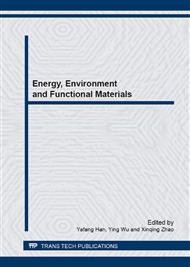[1]
Z. Xia, Q. Xu, P. Guo, R. Wu, Laser-induced damage characteristic of porous alumina optical films, Opt. Commun. 284(2011) 4033-4037.
DOI: 10.1016/j.optcom.2011.04.011
Google Scholar
[2]
S. Liu, N. Hu, G. Yamamoto, Y. Cai, Y. Zhang, Y. Liu, Y. Li, T. Hashida, H. Fukunaga, Investigation on CNT/alumina interface properties using molecular mechanics simulations, Carbon 49(2011) 3701-3704.
DOI: 10.1016/j.carbon.2011.04.059
Google Scholar
[3]
G. Drobychev, A. Barysevich, K. Delendik, P. Nédélec, D. Sillou, O. Voitik, Advances in anodic alumina MCP development, Nucl. Instrum. Meth. A 610(2009) 246-248.
DOI: 10.1016/j.nima.2009.05.076
Google Scholar
[4]
C. Adelmann, D. Cuypers, M. Tallarida, L. N. J. Rodriguez, A. De Clercq, D. Friedrich, T. Conard, A. Delabie, J. W. Seo, J.P. Locquet, S. De Gendt, D. Schmeisser, S. Van Elshocht, M. Caymax, Surface chemistry and interface formation during the atomic layer deposition of alumina from trimethylaluminum and water on indium phosphide, Chem. Mater. 25(2013) 1078-1091.
DOI: 10.1021/cm304070h
Google Scholar
[5]
K.Bordo, H.G. Rubahn, Effect of deposition rate on structure and surface morphology of thin evaporated Al films on dielectrics and semiconductors, Mater. Sci.-Medzg. 18(2012) 313-317.
DOI: 10.5755/j01.ms.18.4.3088
Google Scholar
[6]
O.Sarikaya, Effect of some parameters on microstructure and hardness of alumina coatings prepared by the air plasma spraying process, Surf. Coat. Technol. 190(2005) 388-393.
DOI: 10.1016/j.surfcoat.2004.02.007
Google Scholar
[7]
A. S. Mata, S. C. Ferreira, Jr., I. R. B. Ribeiro, S. O. Ferreira, Anomalous scaling and super-roughness in the growth of CdTe polycrystalline films, Phys. Rev. B 78(2008) 115305.
DOI: 10.1103/physrevb.78.115305
Google Scholar
[8]
J. J. Yang, B. Liu, Y. Wang, K. W. Xu, Homologous temperature dependence of global surface scaling behaviors of polycrystalline copper films, Appl. Phys. Lett. 95(2009) 194104.
DOI: 10.1063/1.3263151
Google Scholar
[9]
S.-H. Woo, C. K. Hwangbo, Optical anisotropy of TiO2 and MgF2 thin films prepared by glancing angle deposition, J. Korean Phys. Soc. 49(2006) 2136-2142.
Google Scholar
[10]
M.-L. Kuo, D. J. Poxson, Y. S. Kim, F. W. Mont, J. K. Kim, E. F. Schubert, S.-Y. Lin, Realization of a near-perfect antireflection coating for silicon solar energy utilization, Opt. Lett. 33(2008) 2527-2529.
DOI: 10.1364/ol.33.002527
Google Scholar
[11]
H. Chu, Y. Huang, Y. Zhao, Silver nanorod arrays as a surface-enhanced Raman scattering substrate for foodborne pathogenic bacteria detection, Appl. Spect. 62(2008) 922-931.
DOI: 10.1366/000370208785284330
Google Scholar
[12]
A. Bonakdarpour, M. D. Fleischauer, M. J. Brett, J. R. Dahn, Columnar support structures for oxygen reduction electrocatalysts prepared by glancing angle deposition, Appl. Catal. A 349(2008) 110-115.
DOI: 10.1016/j.apcata.2008.07.015
Google Scholar
[13]
B. A. Movchan, A. V. Demchishin, Study of the structure and properties of thick vacuum condensates of nickel, titanium, tungsten, aluminium oxide and zirconium dioxide, Phys. Met. Metallogr. 28(1969) 83-90.
Google Scholar
[14]
J. A. Thornton, High rate thick film growth, Ann. Rev. Mater. Sci. 7(1977) 239-260.
Google Scholar
[15]
L.J.He, C. Li, X.Z. Liu, The optical properties of alumina films prepared by electron beam evaporation at oblique incidence, Mater. Lett. 101(2013) 1-4.
DOI: 10.1016/j.matlet.2013.03.049
Google Scholar
[16]
D.L. Smith:'Thin-film deposition: principles and practice', McGraw-Hill, New York, 1995.
Google Scholar
[17]
P. Meakin: 'Fractals, scaling and growth far from equilibrium', Cambridge University Press, Cambridge, 1998.
Google Scholar
[18]
A. H. M. Smets, W. M. M. Kessels, M. C. M. van de Sanden, Vacancies and voids in hydrogenated amorphous silicon, Appl. Phys. Lett. 82(2003) 865-867.
DOI: 10.1063/1.1559657
Google Scholar
[19]
N. M. Hasan, J. J. Mallett, S. G. dos Santos Filho, A. A. Pasa, W. Schwarzacher, Dynamic scaling of the surface roughness of Cu deposited using a chemical bath, Phys. Rev. B 67(2003) 081401.
DOI: 10.1103/physrevb.67.081401
Google Scholar
[20]
M. A. Auger, L. Vázquez, R. Cuerno, M. Castro, M. Jergel, O. Sánchez, Intrinsic anomalous surface roughening of TiN films deposited by reactive sputtering, Phys. Rev. B 73(2006) 045436.
DOI: 10.1103/physrevb.73.045436
Google Scholar


